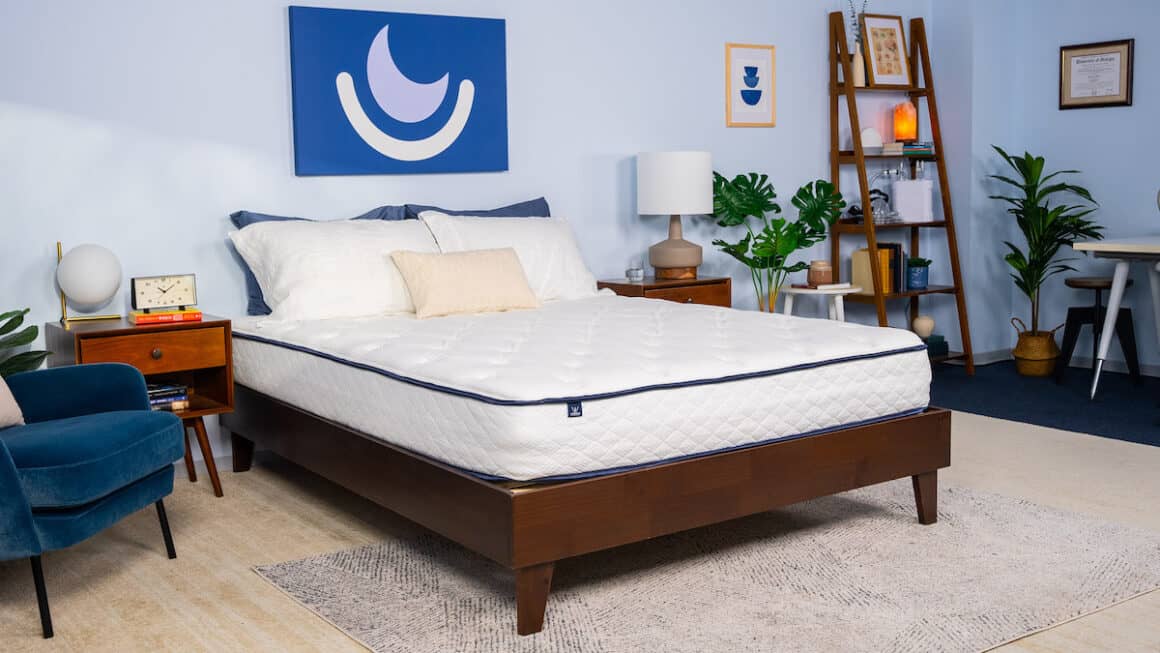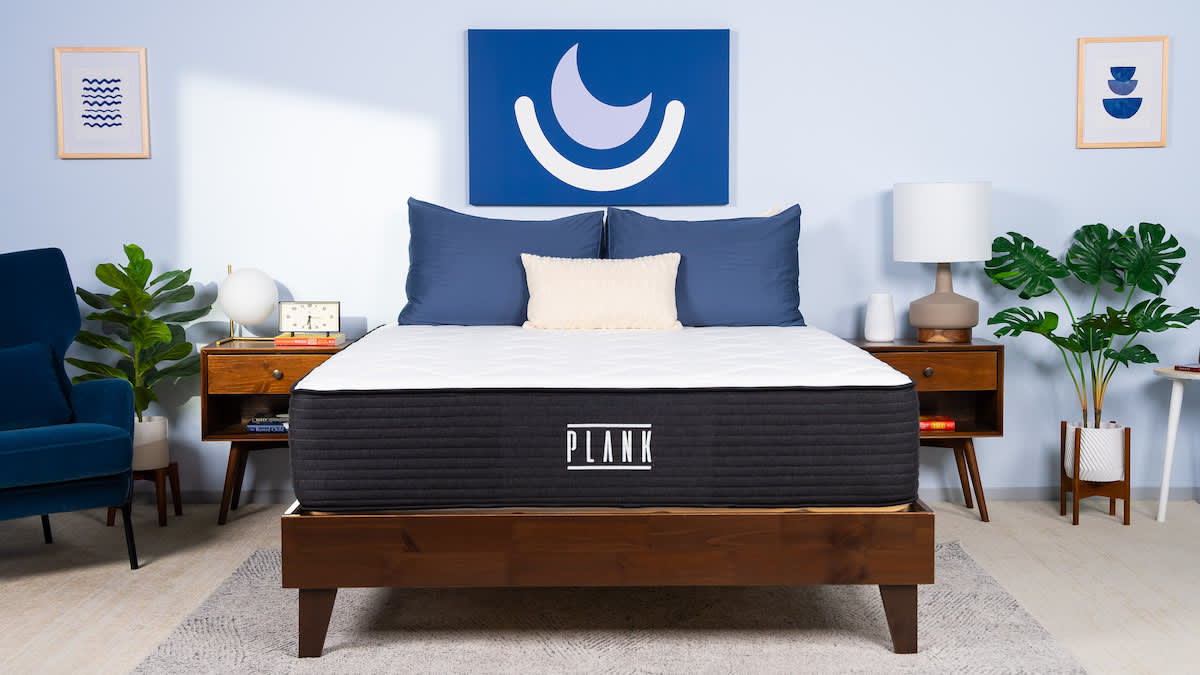On This Page
Best Orthopedic Mattress of 2025: Enhanced Cushioning and Support
Our Top Picks
-
Best Overall Mattress
Saatva Classic -
Best Value Mattress
Brooklyn Bedding Essential -
Best Mattress for Side Sleepers
Helix Midnight -
Most Comfortable Mattress
WinkBeds GravityLux -
Best Mattress for Back Pain
Bear Elite Hybrid -
Best Mattress for Pressure Relief
Nolah Evolution 15 -
Best Firm Mattress
Plank Firm Luxe
Best Overall Mattress
The Saatva Classic has an innovative design that offers cushioning and support in equal measure. Our testers loved the coil-on-coil design, which provided targeted pressure relief for sore spots along the spine while reinforcing the surface. A Euro-top cover also gives the mattress an extra luxurious feel.
Pros & Cons
Pros
- Pocketed microcoils relieve pressure while adding responsiveness
- Euro-top cover is quilted with zoned foam to enhance cushioning and comfort
- Available in two heights and three firmness levels
Cons
- Coils may transfer motion across the mattress surface
- A $99 return shipping fee is deducted from refunds
Ratings
Our Take
Best Value Mattress

The budget-friendly Brooklyn Bedding Essential offers excellent pain and pressure relief with adaptive foam over sturdy pocketed coils. A medium firm feel ensures the ideal balance of plushness, support, bounce, and cooling.
Pros & Cons
Pros
- Foam comfort layers alleviate pressure and isolate motion
- Strong pocketed coils deliver a soothing, mellow bounce
- Below-average pricing for a hybrid
Cons
- Back and stomach sleepers over 230 pounds may sink excessively
- Strong off-gassing odor for the first 72 hours after unboxing
Ratings
Our Take
Best Mattress for Side Sleepers
The Helix Midnight is one of our test team’s favorite models when it comes to balancing support and cushioning. The gentle cradling and sturdy coils make it a great fit for side sleepers in particular.
Pros & Cons
Pros
- Foam layers conform to your body for excellent pressure relief
- Hot sleepers can upgrade with a specialized cooling cover
- Balanced medium firm (6) feel
Cons
- Sleepers who are sensitive to smell may notice off-gassing odors right after unboxing
- May lack firmness for some sleepers over 230 pounds
Ratings
Our Take
Most Comfortable Mattress

Foam mattresses often earn high ratings from our side sleepers, and the WinkBeds GravityLux is no exception. Our side-sleeping testers noted excellent cushioning for sore spots in their hips and shoulders, while the zoned high-density polyfoam prevented them from sinking too deeply into the mattress.
Pros & Cons
Pros
- Zoned polyfoam core provides extra support for the lumbar region
- AirCell memory foam is engineered to dissipate heat for cooler sleep
- Choice of three firmness options
Cons
- Stomach sleepers may find their midsection sinks too deeply into the mattress
- Contouring foam can limit ease of movement
Ratings
Our Take
Best Mattress for Back Pain

Sleepers with persistent back pain often benefit from a mattress with a balance of cushioning for the spine and support to maintain healthy sleep posture. The Bear Elite Hybrid’s foam hybrid construction is a great example of this balance, and three firmness options ensure a comfortable model for most sleepers.
Pros & Cons
Pros
- Breathable cover with specialty Celliant fabric is designed to facilitate both cooling and muscle recovery
- Adaptive memory foam accommodates sharp pressure points
- Transitional layer of zoned polyfoam prevents excessive sinkage
Cons
- Mattress height may require a fitted sheet with extra-deep pockets
- May lack responsiveness for sleepers who want a bouncier mattress
Ratings
Our Take
Best Mattress for Pressure Relief
The Nolah Evolution 15’s deep comfort system excels at pain and pressure relief. Four foam layers create a close cradle for your entire body, and you can choose from three firmness levels based on which sleep position you prefer and how much you weigh.
Pros & Cons
Pros
- Open-cell foam layers conform closely without trapping too much heat
- Zoned coils provide extra pushback around the torso and hips
- Available in three firmness options ranging from medium to firm
Cons
- Strong off-gassing odor for the first few nights
- Couples may notice motion transfer due to the responsive coil system
Ratings
Our Take
Best Firm Mattress

The Plank Firm Luxe has a competitive price-point and a flippable design allowing you to choose from two firmnesses in one mattress. Measuring at a firm (7) on one side and an extra firm (9) on the other, the mattress is one of the firmest in our testing lab.
Pros & Cons
Pros
- Flippable model with two distinct firmness levels
- Robust edges provide more uniform and dependable support
- Optional add-on cooling panel
Cons
- Can feel too firm for many side sleepers
- People with sharp pressure points may prefer a mattress with more cushioning
Ratings
Our Take
Compare Our Top Picks
| Mattress | Mattress Type | Ideal For | Value | Sleep Trial |
| Saatva Classic | Innerspring | Back Sleepers | Fair Value | 365 Nights ($99 Return Fee) |
| Brooklyn Bedding Essential | Hybrid | Budget Shoppers | Great Value | 120 nights (30-night requirement) |
| Helix Midnight | Hybrid | Combination Sleepers | Good Value | 100 nights (30-night requirement) |
| WinkBeds GravityLux | Foam | Combination Sleepers | Good Value | 120 nights (30 night requirement) |
| Bear Elite Hybrid | Hybrid | People With Back Pain | Good Value | 120 nights (30-night break-in period) |
| Nolah Evolution 15 | Hybrid | Most Sleepers | Good Value | 120 nights (30-night requirement) |
| Plank Firm Luxe | Hybrid | Heavy Sleepers | Great Value | 120 nights (30-night requirement) |
What’s an Orthopedic Mattress?
An orthopedic mattress is constructed to boost support for the joints and spine. The materials layered in an orthopedic mattress are designed to work together to relieve pressure and enhance comfort.
In medicine, orthopedics deals with problems affecting the musculoskeletal system, which includes muscles, bones, joints, and connective tissue. An orthopedic mattress is intended to prevent or minimize aches, pains, and other discomfort in this system of the body.
A heightened focus on cushioning, support, and pressure relief distinguishes orthopedic mattresses from standard mattresses.
With this focus, orthopedic mattresses are often best for people with joint and back pain or other musculoskeletal conditions. This includes many older adults and people who have had injuries in the past. Orthopedic mattresses are also popular among athletes who prioritize good sleep as part of their physical recovery.
Unfortunately, there are no official certifications or agreed upon standards for orthopedic mattresses. As a result, manufacturers may label a mattress as orthopedic for marketing purposes even if it lacks materials or features designed to enhance support.
What to Look For in an Orthopedic Mattress
It can be hard to differentiate between all your mattress options, including the many models of orthopedic mattresses. Knowing where to focus your attention can help you choose the best fit for your needs.
Mattress Type
Orthopedic mattresses can be built with a range of materials. Based on their interior construction, mattresses can be categorized into different types.
In a foam mattress, all the layers are made of either polyfoam or memory foam. Foam is a popular material in orthopedic mattresses because of its ability to contour to the body and relieve pressure.
Hybrid mattresses feature top layers of foam, latex, or microcoils above a base layer of metal coils. With their blend of materials, hybrids typically provide solid all-around performance that delivers significant support to the entire body.
Like hybrids, innerspring mattresses have a core of metal coils. But innersprings have few additional layers, which reduces their cushioning and generally prevents them from being orthopedic mattresses.
Every layer in a latex mattress is made with latex rubber. In most cases, this is natural latex that is bouncy, sturdy, and lightly contours to the body. The ability to relieve pressure without excess sinkage can make latex mattresses effective in providing orthopedic support.
Airbeds are unique because their support core is made with air chambers that can be inflated or deflated to adjust the firmness level. Some airbeds have foam or latex on top of these chambers. Real-time firmness modifications provide flexibility to find optimal support.
Firmness
The majority of orthopedic mattresses have a firmness level ranging from medium (5) to firm (7) because this amount of firmness generally provides the best combination of cushioning and support.
If a mattress is too soft, it can cause the body to sink into the bed, jeopardizing sleep posture and pulling the spine out of alignment. If a mattress is too firm, it can create impact and irritation around joints and other pressure points.
Finding the ideal balance depends on your body weight and sleeping position. Your personal comfort preferences are also a factor, which is why there is no one “right” firmness level for everyone.
Video: Are Firm Mattresses Good for You?
Watch our video to learn more about whether a firm mattress is best for you.
Support from a mattress refers to its ability to help keep your spine properly aligned. This means that your spine stays in a neutral position rather than excessively bending or twisting.
Orthopedic mattresses prioritize support because spinal misalignment can cause aches and pains. Solid support typically requires enough cushioning to soften impact at pressure points along with sufficient firmness to keep heavier parts of the body from sinking too deeply into the mattress.
Having the right mattress can help prevent or alleviate certain types of pain. While body pain can have many causes, it can be related to a sleep posture that puts stress on joints and muscles. Orthopedic mattresses are designed to improve sleep posture with effective cushioning and support.
| Pressure Relief | Pressure relief is the ability of a mattress to cushion the areas where stress can build up, such as the hips, shoulders, and lower back. Pressure relief minimizes impact while maintaining stability underneath these key zones of the body. |
| Contouring | Contouring is when a material compresses to match the shape and weight of different parts of the body. Also called conforming or hug, contouring can offer tailored cushioning to the body’s pain points. |
| Responsiveness | Responsiveness is often experienced as bounce or springiness. It refers to how quickly a material regains its shape when weight is removed. Responsiveness keeps you from feeling stuck and contributes to a stable sleep surface that can facilitate better sleep posture. |
Price, Sleep Trial, and Warranty
Mattresses have a wide price range from as low as $300 to over $2,000. How much you’ll pay depends on how a mattress is built, whether it has special materials or features, and whether you can take advantage of any deals or discounts.
If you’re worried about buying a mattress you don’t like, you can get peace of mind with a sleep trial. During the trial, you can return the mattress for a refund. You can expect a sleep trial of 100 nights or more for most mattresses purchased online.
For longer-term purchase protection, a mattress warranty entitles you to repairs or a replacement if your mattress is defective. Mattress warranties often last for 10 years or longer, but they do not cover standard wear and tear.
Is an Orthopedic Mattress Right for You?
An orthopedic mattress may be right for you if you want to improve your sleep posture, struggle with aches and pains, or participate in athletics or physically demanding work. You may also want an orthopedic mattress if you find that you’re unsatisfied with the comfort and support of your existing mattress.
An orthopedic mattress may not be a good fit if you prefer an extra firm bed, have a very limited budget, or are already getting high-quality sleep with your existing mattress.
Pros
- Pressure-relieving materials are designed to cushion “hot spots” and reduce aches and pains
- Added support helps align the spine in a healthy sleep posture
- Enhanced comfort and pain relief may contribute to more consistent and restful sleep
Cons
- Prices can exceed the budget of some shoppers
- May feel too soft for people who want an extra firm mattress
- It can be challenging to sort through marketing claims to identify which mattresses are truly orthopedic
Discover More Mattress Solutions
Take a closer look at our buying guides to explore other top mattresses in different categories.
Mattresses by Construction
How We Test
We take orthopedic mattresses seriously. To make our recommendations, our testing team digs into all the available product data and then puts each mattress through a rigorous in-house testing process to find its benefits and drawbacks.
Our testers have a deep background in sleep products, and each team member offers a unique perspective based on their weight, sleeping position, and personal preferences.
With a combination of both objective and subjective ratings, our team formulates a list of the top-ranking orthopedic mattresses on the market.
Consumer data also plays a role. We consider what customers have chosen as the best-selling orthopedic mattresses, as this confirms our testing team’s lab results are consistent with the experiences of real-world mattress owners.
Frequently Asked Questions
An orthopedic mattress is built to accommodate the joints and spine and, in the process, provide support to the entire body. With added cushioning and pressure relief, an orthopedic mattress is intended to encourage a healthy sleep posture that reduces aches and pains.
Orthopedic mattresses are often worth the investment for people who have bothersome pain in the shoulders, hips, knees, or lower back. These mattresses can also be a great choice for older adults, athletes, or people who work in physically demanding jobs.
For many sleepers, the right orthopedic mattress may prevent or minimize discomfort and make it easier to consistently get a good night’s sleep.
Most orthopedic mattresses range from medium (5) to firm (7), but the best firmness level for an orthopedic mattress depends on your physical needs, body weight, and sleeping position.
Side sleepers, who have major pressure points at their hips and shoulders, often need a mattress with more cushioning. Back and stomach sleepers and people over 230 pounds generally get better support from a firmer mattress.
You can buy an orthopedic mattress online or in a brick-and-mortar department store or mattress showroom. Buying online offers a wider selection and competitive prices. Most online mattresses also come with a sleep trial and free returns, which can be especially helpful in making sure that an orthopedic mattress properly cushions your joints and supports your body.
